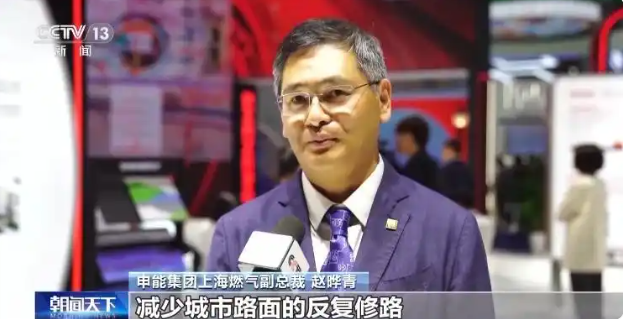
The World Gas Conference was held in Beijing from May 19th to today. It was learned that since China's major oil and gas pipelines were
connected to the grid in 2020, the natural gas transmission volume has exceeded 1 trillion cubic meters, and the daily maximum gas transmission volume has exceeded 1.1 billion cubic meters.
While accelerating the construction of national trunk pipelines, China is promoting the renovation and intelligent upgrading of urban gas pipelines, continuously improving energy infrastructure construction.
The plan is to basically complete the aging and renovation tasks of urban gas pipelines by the end of 2025.
As the earliest city in China to use pipeline gas, Shanghai has launched a large-scale urban renewal and renovation project for old gas pipelines several years ago, and is embarking on a new round of urban "blood vessel" revitalization project.
In 2024, Shanghai completed 719 kilometers of gas pipeline renovation. According to the plan, no less than 750 kilometers of gas pipeline renovation will be completed this year.
Zhao Yeqing, Vice President of Shanghai Gas of Shenneng Group: During the renovation process, we adopted non excavation technology to reduce the repeated road repairs on urban roads.
We are now using a high-precision PVB leak detection vehicle, which can detect even small gas leaks, so that we can promptly rectify any potential hazards.
Along with large-scale updates and renovations, the intelligent upgrading of urban gas pipelines is also steadily advancing in many areas.
Many cities actively introduce cutting-edge technologies such as the Internet of Things and intelligent sensing devices, and achieve upgrading and iteration of gas pipeline operation and management through digital transformation.
On the Qingdao Gas Intelligent Operation Platform, the reporter saw that more than 200000 intelligent devices' data are aggregated in real-time here.
Through IoT sensors and GIS geographic information systems, staff can remotely monitor more than 120 parameters such as pipeline pressure and flow rate, and the warning response time can be compressed from hours to minutes.
Zhang Jinyu, Vice President of Xinao Energy: Through the collection of data from these intelligent devices and the analysis of scenarios, the data is transmitted in real time to our smart operation system, achieving visibility, focus, and management of the entire operation scenario.
With the deepening of the renovation and intelligent upgrading of urban gas pipelines, China's urban gas infrastructure will continue to improve.
Data shows that by 2024, 61000 kilometers of aging and renovation gas pipelines will be completed nationwide, and a total of 163000 kilometers of various pipeline networks will be constructed and renovated throughout the year.
According to the Implementation Plan for Aging and Renovation of Urban Gas Pipelines (2022-2025), China will basically complete the task of aging and renovation of urban gas pipelines by the end of 2025.
Building a diversified natural gas supply system to promote green transformation
As a clean and low-carbon energy source, the supply and demand of natural gas are increasing year by year.
In recent years, China has accelerated the construction of a diversified new natural gas supply system, focusing on the expansion of maritime channels, interconnection of onshore pipelines, and substitution of terminal energy.
As the "first gateway" for offshore liquefied natural gas resources to enter the domestic market, the intensive construction of coastal liquefied natural gas receiving stations is pressing the "fast forward button".
At present, 32 liquefied natural gas receiving stations have been built along the coast of China, with an annual designed unloading capacity of over 100 million tons.
At present, the expansion projects of multiple liquefied natural gas receiving stations have entered a critical construction stage. After the completion of the projects, China's liquefied natural gas receiving, storage, and supply capabilities will be further enhanced.
Yang Yong, Deputy General Manager of China National Offshore Oil Corporation (CNOOC): In order to enhance China's independent and controllable ability in liquefied natural gas transportation, CNOOC is actively building an international first-class liquefied natural gas transportation fleet.
Independently design and construct 12 large liquefied natural gas transport ships, with an additional 10 under construction, with a total capacity of over 3.6 million cubic meters in the future.
Not only in coastal energy hubs, but also the green transformation of inland shipping is accelerating.
Relying on the policy of "new energy ships trade in the old for the new", the traditional fuel oil ships are accelerating the "oil to gas" on the golden waterways of the Yangtze River, the Pearl River and other rivers. The carbon emissions of the transformed ships can be reduced by 25%, and the operating costs can be reduced by 15%.
Yang Xiaohu, President of CIMC Anruike: We have undertaken nearly 300 ship renovation tasks in the first quarter of this year, and we expect to have 6000 to 8000 ships in the next 3 to 4 years.
Data shows that in the past decade, China's annual natural gas consumption has jumped from less than 200 billion cubic meters to over 400 billion cubic meters, with an average annual growth rate of 9%.
It is expected that by 2025, the demand for natural gas in China's market will reach 450 billion cubic meters, accounting for over 10% of primary energy consumption. By 2035, this proportion will increase to over 15%, becoming a key support for energy structure transformation.
Wan Jinsong, Deputy Director of the National Energy Administration: Natural gas consumption is showing a rapid growth trend. We should fully leverage the advantages of clean and low-carbon natural gas, strengthen its role in optimizing the energy consumption structure, promote the green transformation and development of the natural gas industry, and build a modern energy system with multiple complementary and efficient synergies.